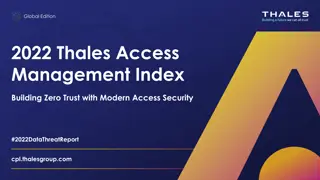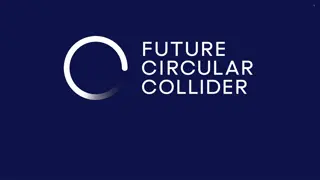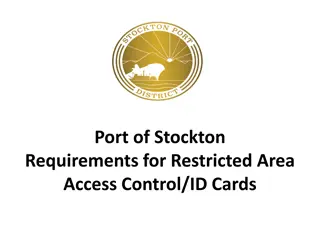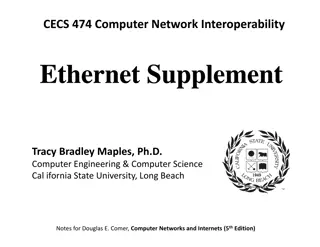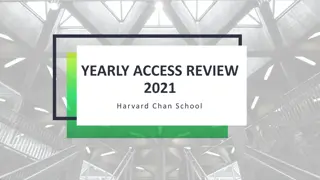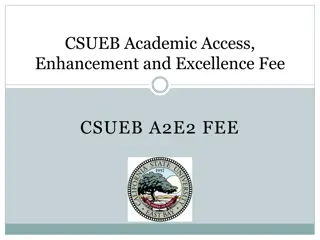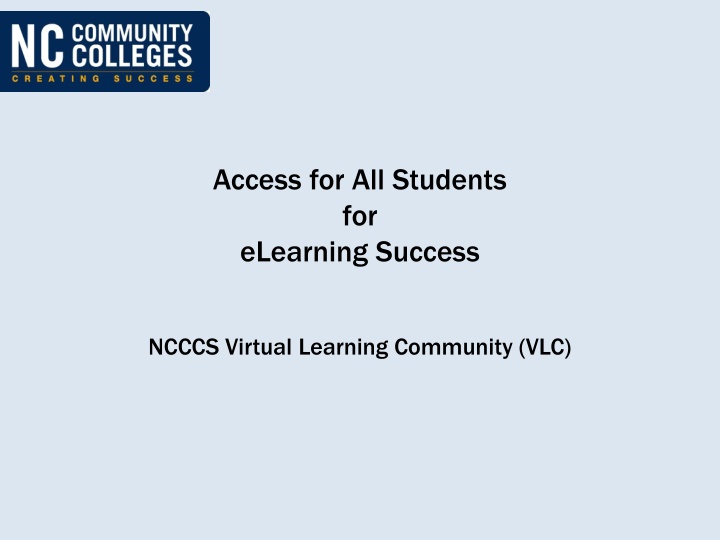
Access for All Students for eLearning Success: Importance and Equality
Learn the significance of ensuring online content accessibility for all students, including those with disabilities. Explore the reasons, regulations, and benefits of equal access to virtual learning environments. Discover the essential steps and philosophy behind providing inclusive eLearning opportunities for every student in the NCCCS Virtual Learning Community.
Download Presentation

Please find below an Image/Link to download the presentation.
The content on the website is provided AS IS for your information and personal use only. It may not be sold, licensed, or shared on other websites without obtaining consent from the author. If you encounter any issues during the download, it is possible that the publisher has removed the file from their server.
You are allowed to download the files provided on this website for personal or commercial use, subject to the condition that they are used lawfully. All files are the property of their respective owners.
The content on the website is provided AS IS for your information and personal use only. It may not be sold, licensed, or shared on other websites without obtaining consent from the author.
E N D
Presentation Transcript
Access for All Students for eLearning Success NCCCS Virtual Learning Community (VLC)
Overview Why make content accessible? Equal Access Regulations Standards Lawsuits/Resolutions Assistive Technology Who is a student with a disability? Types of Impairments Model of Reform Steps to Accessibility Questions?
Why do we need to make online content accessible? 1. Federal Regulations 2. State Regulations 3. It s the Right thing to do! 4. Lawsuits are expensive! Disability Rights groups are helping students to file lawsuits BUT BUT -- -- The number one reason for making online content The number one reason for making online content accessible is to allow people to access your services and accessible is to allow people to access your services and your content effectively and easily. It is not just to meet a your content effectively and easily. It is not just to meet a series of checkpoints. series of checkpoints.
Basic Philosophy All students, regardless of disabilities or learning styles, need access to websites and electronic/digital content to be successful in college! eLearning allows the citizens of NC to Learn. Virtually Anywhere. (the Virtual Learning Community trademark) in order to advance their career and educational goals even those with special needs! Whether in a F2F class or online, students need to access digital content and websites to succeed.
What is Equal Access? OCR s guidance on emerging technology sets the standard: Receive all the educational benefits provided by the technology in an equally effective and equally integrated manner Must be able to: Acquire the same information, Engage in the same interactions, and Enjoy the same services. Colleges should closely review all programs, services, or activities delivered Are these same activities/services offered over the website/electronically for students with disabilities?
Equal Access Students must be able to: Acquire the same information Engage in the same interactions Enjoy the same services Colleges should closely review all programs, services, or activities delivered Are these same activities/services offered over the website/electronically for students with disabilities?
What are the laws/regulations? Section 504 of the Rehabilitation Act of 1973 www.ed.gov/policy/rights/reg/ocr/ Section 508 Summary www.section508.gov/index.cfm?fus eAction=stdsSum Title II of the Americans with Disabilities Act of 1990 www.ada.gov/2010_regs.htm NC regulations under Senate Bill 866 www.ncga.state.nc.us/Sessions/2001/Bi lls/Senate/HTML/S866v6.html
Regulations Section 504 State or local governments may not discriminate against qualified individuals with disabilities. All government facilities, services, and communications must be accessible consistent with the requirements of section 504 of the Rehabilitation Act of 1973. (DOE Office for Civil Rights website: http://www2.ed.gov/about/offices/list/ocr/inde x.html?src=oc)
NC Senate Bill 866 " 168A 168A- -7. 7. Discrimination in public service. Discrimination in public service. (a) It is a discriminatory practice for a State department, institution, or agency, or any political subdivision of the State or any person that contracts with the above for the delivery of public services including but not limited to education, health, social services, recreation, and rehabilitation, to refuse to provide reasonable aids and adaptations necessary for a known qualified person with a disability to use or benefit from existing public services operated by such entity; provided that the aids and adaptations do not impose an undue hardship on the entity involved. This subsection includes equivalent services provided via information technology. (b) A State department, institution, or agency, any political subdivision of the State, and any person that contracts with these entities for the delivery of public services shall administer its services programs, and activities in the most integrated setting appropriate to the needs of persons with disabilities."
What does the Senate say about Accessibility? Access to Technology Senate Hearing (opens in new window)
What are the standards? Section 508 Checklist http://webaim.org/standards/508/checklist Web Content Accessibility Guide 2.0 Level AA http://www.w3.org/TR/WCAG/ NC state standard for web accessibility is WCAG 1.0 WCAG 2.0 Level AA is the de facto standard in most resolutions, even those settled outside of court!
What is WCAG? Web Accessibility Initiative of the World Wide Web Consortium W3C Public/private world-wide consortium of academics, governments, technology industry, and user groups Web Content Accessibility Guidelines (level 1) Level I is the standard in NC ITS Statewide Technical Architecture documentation (as of 2004) http://www.ea.scio.nc.gov/library/pdf/archives/Application%20Domain %20-%20Principles,%20Standards,%20Practices.pdf Standards for NC will be revised within the next 2 years per the ITS Enterprise Architect www.w3.org/wai See Evaluating Accessibility
Lawsuits South Carolina Community and Tech. Colleges Voluntary Resolution Agreement with DOE in March 2013 to ensure all websites in SCTCS are ADA compliant. http://www.ed.gov/news/press-releases/civil-rights- agreement-reached-south-carolina-technical-college- system-accessibi OCR found that the sites were not readily accessible to persons who are blind, have low vision, or have other print-related disabilities.
South Carolina Under the terms of the agreement, SCTCS and its board will: Develop a resource guide that provides information about web accessibility requirements; Direct that the SCTCS website and the websites of all the member colleges be accessible to students with disabilities; and Annually review the system s and colleges websites and monitor steps taken to correct any accessibility problems identified.
Louisiana Tech. University Settlement with Dept. of Justice, July 2013 Under the settlement agreement, the university will adopt a number of disability-related policies, including the requirement to deploy learning technology, web pages, and course content that is accessible in accordance with the Web Content Accessibility Guidelines (WCAG) 2.0 Level AA standard http://www.justice.gov/opa/pr/2013/July/13-crt-831.html
Penn State University November 12, 2010, NFB filed a complaint with the Department of Education regarding Web and other IT used on Penn State campuses. In 2011, this complaint was settled and required Penn State to make sweeping changes to their Web content (it agreed to follow the WCAG 2.0 level AA) and its IT generally (including IT used in classrooms, campus banking, library services, etc.). http://blog.hisoftware.com/2013/accessibility/web-accessibility-in- higher-education
San Jose State University By an agreement signed on January 19, 1996, SJSU agreed to implement a voluntary resolution plan. Personal reader is not sufficient flexibility and freedom through software/assistive tech. Must also provide training on use of tech. http://people.rit.edu/easi/law/sjsu.htm
Must Educators Provide Assistive Technology for Disabled Students to Access Distance Learning Activities? Generally, no. Think of most specialized computer equipment - assistive technology - as being like mobility equipment (wheelchairs, etc.). They are generally the responsibility of the individual with a disability. If they provide laptops/iPads to incoming students, they must provide accessible equipment with assistive technology to students with disabilities! If they provide open access computers for student use, they must provide appropriate number with assistive technology However 18
OCR Guidance on Accessible Technology Joint OCR-DOJ Dear Colleague Letter on Electronic Book Readers (June 29, 2010) www.ed.gov/ocr/letters/colleague-20100629.html FAQ About the June 29, 2010 Dear Colleague Letter (May 26, 2011) www.ed.gov/ocr/docs/dcl-ebook-faq-201105.html Ed.gov Logo
Assistive Technology Options Disability-specific devices that allow people to use computers and other technology: Alternatives, such as foot pedals, for people who cannot use a computer mouse Screen readers and refreshable braille devices for people who are blind or have other print disabilities Open or closed captioning for people who are deaf
Other Assistive Technologies Screen Readers including: Voiceover for Macintosh Jaws for Windows Adaptive Keyboards Scroll wheels and large trackballs Eye Tracking Devices Voice Recognition Software Various Prosthetic Devices Screen Magnification
Websites vs. Distance Learning Distance learning: the technology supporting live courses should be designed to be adaptable (no need to actually provide real- time captioning, if there s no student who needs captioning currently enrolled, but educators should be ready to do so if a student with a disability joins the class). Websites: All websites should be designed to be accessible to individuals with disabilities. The intersection of websites and distance learning: If an archived course is available online upon demand, then it should be captioned before posting or the educator should be ready to provide another means of effective communication. Students access an online course through a website/portal!
Who is a Student with a Disability? Has a physical or mental impairment which substantially limits one or more major life activities, or Has a record of such impairment, or Is regarded as having such impairment.
What types of impairments should we consider in content design? Visual Impairments students use screen readers to convert visual information to speech Hearing Impairments can t listen to videos so they need captioning Mobility Impairments use speech recognition software or assistive technology to navigate sites, tab navigation (no mouse) Low Vision need to adjust font or color easily
Benefits Accessible courses benefit all students. Accessible courses, designed with accessibility and Universal Design for Learning (UDL) in mind, are beneficial to all students, not just those with a disability. Good course design saves time. Designing and building your course right the first time, saves time in having to rebuild it later on. It's the law. Online content is required to meet the standards of Section 504 of the U.S. Rehabilitation Act. Example
Universal Design Universal Design for Learning Universal Design for Learning is a set of principles for curriculum development that give all individuals equal opportunities to learn. Goes beyond accessibility for students with disabilities 3 main principles (http://www.udlcenter.org/aboutudl/whatisudl/3principles) Provide Multiple Means of Representation Provide Multiple Means of Action and Expression Provide Multiple Means of Engagement
Model of Reform at a Glance... Five (5) Years to Compliance (actually 4 left) Gather baseline information Gain top-level support Organize an accessibility committee Define a standard Create an implementation plan Provide training and technical support Monitor conformance Remain flexible through the changes Every organization will need to adapt this model to it's own circumstances, but the general principles apply across organizations and circumstances.
How do I begin? Start Small ADA Forum perhaps Awareness and Knowledge Key Identify all digital content used in instruction Instructional websites sites Web applications and sites contracted Require ADA Compliance statement in all contracts Online forms PDF files Word docs PowerPoint files Videos
5 Steps to Accessibility Follow these five steps to make online courses accessible. 1. Speak Visually 2. Use Plain Language 3. Keep it Simple 4. Select Multi-Sensory Materials 5. Request Accessible Materials
Use Plain Language Context: Do learners have the background knowledge to understand what is being said? Concrete: Is the language clear? Are examples relevant? Can learners picture in their minds what is being said? Simplicity : Are important ideas in logical order? Design: Is the material easy to look at with enough white space? Readability: Does the level of the material match the intended audience?
Keep documents simple Headings Nested Properly Lists Used Correctly Simple Tables Chunked Content Adequate Color Contrast Do Not Use Color Alone
Make sure all materials are available to more than one sense Audio Captions and Transcripts Alternative Text / Long Descriptions
Why Caption? Importance of Captioning (opens in new window)
Insist on accessible publisher content BUYER - BE AWARE! Ask for a VPAT the Voluntary Product Accessibility Template We are required by law to procure only accessible content, but the publisher is not obligated to provide accessible content
Voluntary Product Accessibility Template A VPAT is a vendor-generated statement that provides information on how a product or service conforms to Section 508 Accessibility Standards (from the U.S. Access Board) for Electronic and Information Technology in a consistent fashion and format. Request VPAT statement in all contracts and purchases for electronic content.
Are Our Tools and Technology Usable by All? Have We Considered Students who are blind or visually challenged? Students who are deaf or hearing impaired? Students with physical disabilities? Students with challenges more difficult to discern? FACULTY AND STAFF with varying needs?
Potential Problems Learning Management Systems Web Pages Web-based Tools and Resources Digital Student Services Publisher Provided Content All types of technology used by students, staff, and faculty
The Path to Accessibility File formats that are user friendly Compatibility with Assistive Technology Text image descriptions that can be voiced Full keyboard access to Web-based content Mathematical, scientific, and music symbols, formulas, and notations represented in multiple ways e-book content that can be voiced and navigated Purchase Accessible Learning Materials Initiative PALM National Center on AIM at CAST
Resources National Center on Accessible Instructional Materials PALM Initiative (Purchase Accessible Learning Materials) http://aim.cast.org/learn/practice/palm#.VA4fYxaGO5U
How can the Virtual Learning Community help?
Contact Information Wanda Barker barkerw@nccommunitycolleges.edu Candace Holder holderc@surry.edu Jennifer Jones pdcenter@waketech.edu


